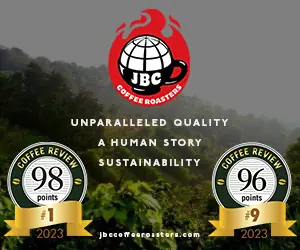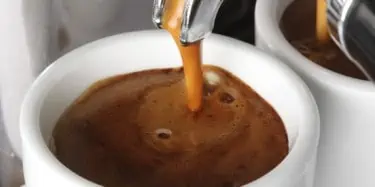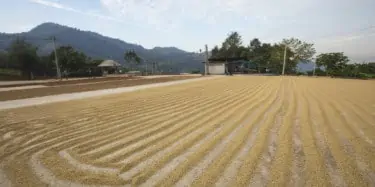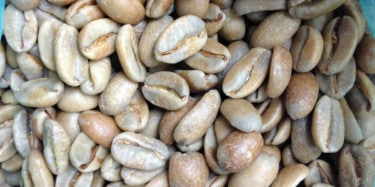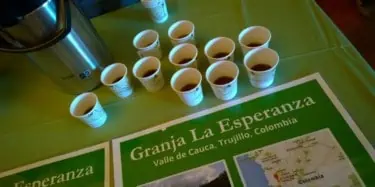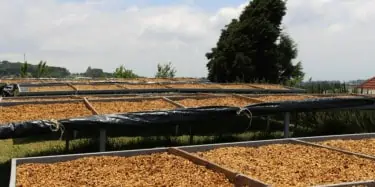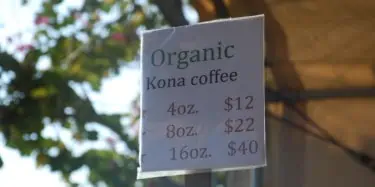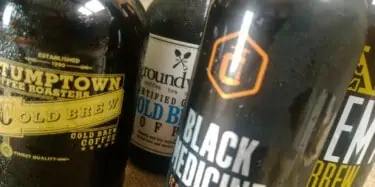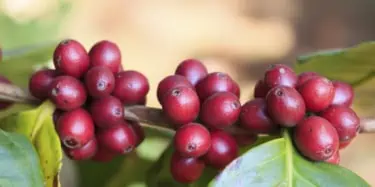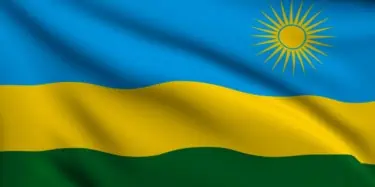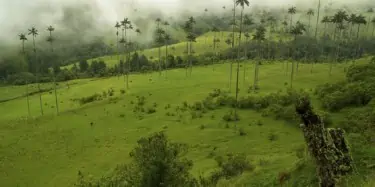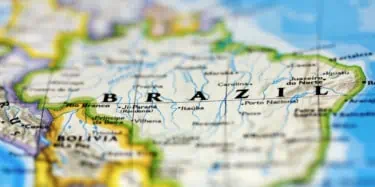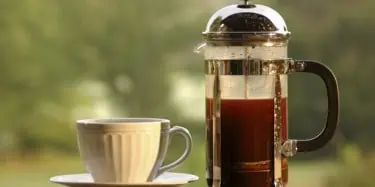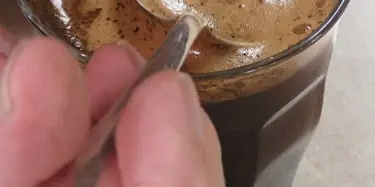For the past ten years or so smaller, hipper, more nimble roasting companies have dominated the coffee conversation in America, outflanking Starbucks in roast style (lighter than Starbucks), freshness (roast-dated packaging), coffee selection (precisely identified seasonal small lots), brewing (by the cup, often by hand), and even design sensibility (usually blunt, simple and utilitarian, often
Tasting Reports – Most Recent
Coffee Review has published more than 250 monthly coffee tasting reports since February 1997. The most recent tasting reports appear below in reverse chronological order. You may narrow your search by category from the main navigation drop-downs or by using the key word search feature that appears in the page header. The content in tasting reports and associated reviews was correct at the time of publication but may not remain accurate over time.
Open Source Espresso Blends
With this espresso tasting we focus on what appears to be a new trend in espresso blending – the open disclosure to customer and competitor of the identity of the specific green coffees that compose a blend, as opposed to the deliberate secrecy around blending that has prevailed in the coffee industry for decades. The old approach to blending implied secret mastery of arcane coffee knowledge that
Elegant Earth: Wet-Hulled Sumatras and One Sulawesi
Wet-hulling is not an obscure Olympics sailing event nor (at least to my knowledge) a special trick in waterskiing or wakeboarding. It is a fruit removal and drying variation that contributes much of the distinct character of traditional Indonesia coffees, particularly those from Sumatra and Sulawesi. It is also practiced on other Indonesian islands, almost everywhere in Indonesia where small
The Everyday Exceptional: Macro-Lots 2015
Coffees that attract a high rating on Coffee Review are often produced from very small, or “micro” lots of green coffee, specially selected for quality and distinctiveness, precisely described in regard to botanical variety and other details, and not likely to be available for more than a couple of months before they’re sold out. And usually (though not always) they cost considerably more than
K-Cups and Other Cups: Capsule Single-Serve Coffees
When Coffee Review last visited the single-serve filter-coffee capsule scene in 2013, smaller, high-end roasting companies were eyeing the soaring popularity of Keurig K-Cups with some apprehension and, in a few cases, with interest: Hey, maybe I can get in on the action once the patents start lapsing. However, based on what we encountered during this month’s tasting, it seems that most higher-end
Top 30 Coffees of 2014
We are pleased to present our Top 30 Coffees of 2014, Coffee Review’s second annual ranking of the most noteworthy coffees we reviewed over the past year. We selected and ranked these exceptional coffees and espressos based on quality (represented by overall rating), value (reflected by most affordable price per pound), and consideration of other factors that include distinctiveness of style,
Holiday Gift Coffees: Blends and Beyond
This holiday season may mark the definitive return of the blend to the high-end specialty coffee scene after years of almost exclusive dedication to ever-more-refined single-origin offerings. The excitement and ingenuity of many of the holiday-themed blends we sampled this past month certainly suggest such a revival. The holiday blend, a long-standing staple of the specialty coffee business in the
Geshas and the Rest: Single-Variety, Single-Lot Coffees
The variety play – marketing coffee by the botanical variety of the tree that produced the coffee – is one of the latest trends in the high-end specialty world. True, some roasters who submitted samples for this month’s article still confused tree variety (botany) with origin (geography), and sent us coffees from a single growing region (Sumatra, say) rather than coffees that reasonably can be
Roast, Variety, Sustainability: HarVee Awards Coffees 2014
Some of the more interesting trends and issues that surfaced among the thirteen prize-winning coffees reviewed this month from the recent Let’s Talk Coffee/Sustainable Harvest HarVee award competition in Panama range from how (the coffees were roasted), to what (tree varieties produced the coffee) to who (produced the coffee). As far as roast goes, we cupped coffees roasted from the far honeyish
Honey and Natural Process Coffees, Central America 2014
Nine years ago I organized a panel for the Specialty Coffee Association of America called “Using Alternative Processing Methods to Create Product Differentiation: Perspectives and Opportunities.” Presented in Spanish and English, it attracted around five hundred coffee producers and roasters. The overall premise of the panel was simple: coffee is no longer a commodity beverage but a specialty
Hawaii 2014: The Classics Rule
When writing about Hawaii coffees – more specifically, Kona coffees – I invariably feel conflicting impulses about whom to take on. Should I attack the many cynical Kona-bashers among the mainland high-end coffee-roasting community who sneer that Hawaii coffees (Kona in particular) are at best ordinary and always overpriced? On the other hand, should I rattle the bars of the sun-and-sand besotted
Bottled Iced Coffees
North American cafés for some years now have been brewing coffee in advance to refrigerate and serve over ice on warm summer days. The brewed, refrigerated coffee is usually prepared by the cold-brew method: ground coffee is steeped in cool or room temperature water for around ten to twenty-four hours, and after this prolonged extraction, filtered and stored in the refrigerator until it is served
Subtle Exoticism: Sulawesi and Papua New Guinea
This month’s reviews include coffees from two Indo-Pacific growing regions, the Indonesian island of Sulawesi (formerly Celebes) and Papua New Guinea. We had planned to include coffees from several other Indo-Pacific islands – Java, Bali, East Timor – but we were not able to source enough samples to justify including them. Never mind; we turned up some superb and original coffees from these two
Rwanda and Central Africa: Sweet and a Hint of Savory
Perhaps a more accurate geographical descriptor for the coffee origins we focus on this month may be African Great Lakes coffees rather than Central Africa coffees. The growing regions that produced almost all of the thirty coffees we cupped this month are clustered around or near the gigantic lakes that dominate the geography of the mountainous central-east region of Africa, at or near the
Colombia on the Rebound
When we last tested Colombias two years ago we turned up several fine coffees, but generally were disappointed by the many samples that arrived bearing fancy names but displaying little distinction in the cup. Back then the trend toward select, precisely identified lots of green coffee (aka “direct trade,”“microlots”) seemed to have been honored more in name and hype than in distinction and
Subtle but Not Tame: Brazils 2014
The various cup profiles associated with the world’s coffee regions are the result of a complex interplay between nature and nurture, between the givens of nature – growing altitude, soil and rainfall patterns – and local traditions that for decades determined the varieties of coffee tree typically grown in a region and how the fruit was typically harvested and processed. The sum total of this
State of the Blend 2014
To say that blends are out of style (at least for drip and French press brewing) in the contemporary high-end world of specialty coffee would be an understatement. Today one seldom sees blends intended for drip brewing featured by cafes and roasting companies with serious upscale coffee aspirations. And any drip blend that does show up is lost among the exotic crowds of direct-trade, micro-lot,
Top 30 Coffees of 2013
Coffee Review introduced 100-point reviews to the specialty coffee industry in 1997. Over the years since then we've cupped tens of thousands of samples and produced reviews for nearly 3,500 coffees. We are often asked, "What is the best coffee?" To which we give the obvious answer: "There is no single 'best' coffee." Of course, visitors to our website can sort through the reviews to draw their
Holiday Blends and Gift Coffees
This month’s reviews fall neatly into two categories: first, five exceptional holiday blends; second, an assortment of fine single-origin coffees offered only for the holidays that range from versions of familiar names to three holiday splurge coffees likely to satisfy money-is-no-object gift-giving and holiday impulsiveness. Starting with the holiday blends, the most striking finding of this
Dried-in-the-Fruit Refinement: Ethiopia and Yemen Naturals
At this moment I am drinking a cup of a coffee labeled “Ethiopia Amaro Natural.” It was sourced and roasted by Old Soul, an artisan baker and small-batch coffee roaster in Sacramento, California. Aficionados and regular readers of Coffee Review know that “natural” is the latest name for coffee dried inside the whole fruit, rather than after the fruit residue has been removed, as is the case with





